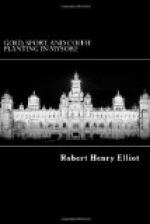I have said that the bison, unless molested, will never attack man, and I was so confident of this that I once sent a highly valued European in my employ, to photograph a solitary bull, merely sending with him a native with a gun, and with instructions to fire in the event of the photographer being attacked. I selected a small piece of open swampy grass ground in a detached piece of jungle through which solitary bulls often passed, and knowing the direction of the wind at that season of the year, had no difficulty in avoiding any chance of the bull winding the photographer. The camera was placed on the edge of the jungle, and presently a bull came slowly grazing along the swamp, when he unluckily looked up to find the photographer just taking the cap off, within about ten paces. Never was there anything more annoying, and the thing would have been a magnificent success had my man been provided with the instantaneous process. But he was not, and the bull turned and fled through the mud with a most tremendous rush, having, I suppose, taken the lens for the glare of the eye of some new kind of tiger. The sudden change in the appearance of the bull was described to me as being most remarkable, for as he grazed quietly along he appeared to be one of the most harmless and domestic of animals, while the moment the sight of the camera fell on his astonished vision he was at once transformed into the wildest looking animal conceivable.
It is difficult to believe that big game in remote spots can perceive whether a man means to harm them or not, but it is remarkable that when on his way to the jungle alluded to, the photographer passed two sambur deer in the long grass, and at no great distance away, and saw them still lying there on his return. A bear was also rolling and grunting in the jungle close to him as he was waiting for the bull. On his return to the hut (put up for the occasion about a mile away) he was amused to find the native servant I had sent with him seated between two roasting fires which he imagined, and perhaps not without reason, would prevent his being attacked by a tiger. During the absence of my amateur photographer either a tiger or panther had passed close to the hut.
The photographer returned to the swamp on the following morning, but no bull arrived, and I gave up the attempt to obtain a photograph of a bison. But it is time now to describe the bison.
The Indian bison (Gavoeus Gaurus, sometimes called the Gaur) is the largest member in the world of the ox tribe. It is quite free from mane or shaggy hair of any kind. The cows are of a dark brown, while in mature and old bulls the colour approaches to black. The legs from the knee downwards are of a dirty white (I once saw two bison with apparently blue legs, the colour being caused by standing on ashes, and this gave them a very remarkable appearance), and so is the forehead. The bison has no hump. It has a marked peculiarity in the shape of the back




